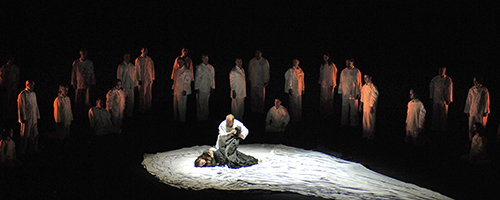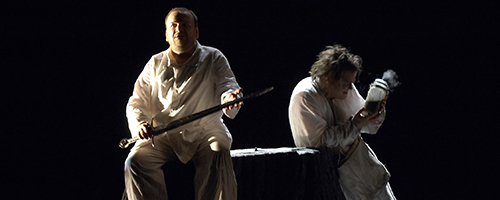-
8 Things to Know: Siegfried
By Nikita GourskiPosted in Siegfried
1) It’s the third instalment of the Ring
One of the most ambitious works of art ever created, Wagner’s Ring is a monumental cycle comprising four interconnected operas. Siegfried is the third instalment of the saga, in which the title character undertakes a psychological journey towards self-understanding, attempting to piece together the story of his origins and grasp his place in the world. In the process, he forges the broken magical sword called Nothung, slays the dragon Fafner, and braves a ring of fire to reawaken Brünnhilde with a kiss, pushing the allegorical story of the Ring toward its inexorable conclusion in Götterdämmerung.

2) Like stepping into a river
At five hours (including two intermissions), Wagner’s Siegfried develops themes over long arcs of time, as opposed to short bursts of melodic activity. Conventional operas in the late 1700s and early 1800s were structured around the alternating use of two distinct forms of musical writing: (a) lushly orchestrated individual arias, i.e. “set pieces,” and (b) recitative sections, which served to communicate plot information through dialogue to the audience and to link together the big arias of an opera. By the mid- to- late-19th century, however, composers like Wagner began to react against what they perceived as the artificiality of this approach, in which a pyrotechnic aria might suddenly burst out of the action without a dramatically coherent buildup to warrant its emergence. By being slotted in for its beauty rather than musico-dramatic function, the conventional aria runs the risk of being less-than-credible in advancing the story’s emotional stakes. By contrast, Wagner’s vision synthesizes drama and music into one continuously moving, momentum-gathering, emotionally textured whole. Because the score eschews the traditional separation of aria/recitative, the opera builds its tensions, conflicts, and revelations through much more organic, immersive means, fusing orchestra and voice into an indivisible musical experience.
3) Famous numbers
That being said, each of the three acts in Siegfried contains a standout section that could be categorized as a “set piece”: the Forging Song in Act I, in which Siegfried hammers away at the magic sword to restore the broken blade; the evocative sequence in Act II known as Forest Murmurs, in which Siegfried, surrounded by the sounds of the forest, contemplates the parents he never knew and fixes on the song of a Forest Bird, who will eventually guide him to Brünnhilde; and the extended love duet of Siegfried and Brünnhilde that constitutes the opera’s finale.

4) COC Music Director Johannes Debus conducts his first Siegfried
“For an opera like Siegfried, I try to understand the ‘structure’ of the piece—the architecture of each act—trying to somehow connect the very beginning with the very end and, by doing that, build this arc over the whole evening.” With this production, Maestro Debus leads the 106-piece COC Orchestra through an electrifying score of unparalleled musical storytelling.
5) François Girard
Our production of Siegfried is directed by critically acclaimed Canadian film and stage director François Girard. His production has been hailed as “intellectually incisive” and “dazzling” (Opera News); “psychologically rich and mysterious” (NOW Magazine), as well as “awe-inspiring” (Toronto Star).

6) Representing Siegfried’s mind
The set designs by celebrated Toronto-born designer Michael Levine represent the fragmented state of Siegfried’s psyche and memory. There are several elaborate constructions that hold a whirling mass of “memory debris”—including people from Siegfried’s past, remnants of Valhalla, weapons, etc.—suspended above the stage. The use of this “memoryscape” (which changes its configuration in significant ways from act to act) opens the door to a multiplicity of interpretations about the reality of what is happening to Siegfried: is it his imagination, his desire, an actual journey, or the unravelling of a mind that we are witnessing?
7) Scaling Everest, Scaling Time
Girard is aware of the challenges inherent in staging Wagner’s long spans of time. In response, he has opted to use very clear and precise on-stage movement, eliminating any unnecessary action to heighten the emotional impact of simple gestures and allow the audience to embrace a new impression of time. Assisting in the formidable task is the award-winning Canadian choreographer Donna Feore.
8) Leading Wagnerians
German tenor Stefan Vinke, Siegfried
“Huge of voice, unflagging of stamina, imaginative and energetic on the stage.” Seattle Times
American soprano Christine Goerke, Brünnhilde
“she possess[es] everything a great Brünnhilde must have: dignity, stature, and a voice of molten gold.” Toronto Star
American bass-baritone Alan Held, The Wanderer
“A commanding performer.” NOW Magazine
See our production live onstage from January 23 - February 14, 2016. To learn more about the production, visit here.
Photo credits (top - bottom): A scene from Siegfried (COC 2006), photo: Michael Cooper. Susan Bullock as Brünnhilde lying on ground with Christian Franz as Siegfried in Siegfried (COC 2006), photo: Gary Beechey. Laura Whalen as the Forest Bird in Siegfried (COC 2006), photo: Michael Cooper. Christian Franz as Siegfried and Robert Künzli as Mime in Siegfried (COC 2006), photo: Michael Cooper.
